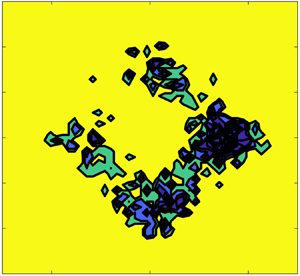Published online by Cambridge University Press: 21 April 2021

This paper presents low-order models of Rayleigh–Bénard convection of a radiating gas in a cubic cell, in the Rayleigh number range  $Ra \in [ 10^6\text {--}10^8 ]$. Numerical simulations are carried out for an air–
$Ra \in [ 10^6\text {--}10^8 ]$. Numerical simulations are carried out for an air– $\textrm {H}_2\textrm {O}$–
$\textrm {H}_2\textrm {O}$– $\textrm {CO}_2$ mixture assumed to be radiating (coupled case) or transparent (uncoupled case). When coupling with radiation, it is shown that the kinetic energy of the flow and the thermal energy increase. At
$\textrm {CO}_2$ mixture assumed to be radiating (coupled case) or transparent (uncoupled case). When coupling with radiation, it is shown that the kinetic energy of the flow and the thermal energy increase. At  $Ra=10^6$, planar flow states are observed when radiation is taken into account, while diagonal flow states prevail in the uncoupled case. From
$Ra=10^6$, planar flow states are observed when radiation is taken into account, while diagonal flow states prevail in the uncoupled case. From  $Ra\ge 3\times 10^7$, quasi-stable diagonal flows are observed in both coupled and uncoupled simulations, with occasional brief reorientations. The reorientation frequency seems to decrease with the Rayleigh number and seems to increase with radiation. A proper orthogonal decomposition (POD) analysis reveals that 11 of the first 12 POD eigenfunctions are preserved over the Rayleigh number range, whatever the coupling conditions. However, POD eigenvalues are higher with radiation. POD-based low-order models are derived at different Rayleigh numbers, for both coupled and uncoupled cases. Radiative transfer effects are added in the model in an a priori fashion, from uncoupled simulation data. Coupled POD models predict the energy increase with radiation and the loss of stability of the diagonal rolls at
$Ra\ge 3\times 10^7$, quasi-stable diagonal flows are observed in both coupled and uncoupled simulations, with occasional brief reorientations. The reorientation frequency seems to decrease with the Rayleigh number and seems to increase with radiation. A proper orthogonal decomposition (POD) analysis reveals that 11 of the first 12 POD eigenfunctions are preserved over the Rayleigh number range, whatever the coupling conditions. However, POD eigenvalues are higher with radiation. POD-based low-order models are derived at different Rayleigh numbers, for both coupled and uncoupled cases. Radiative transfer effects are added in the model in an a priori fashion, from uncoupled simulation data. Coupled POD models predict the energy increase with radiation and the loss of stability of the diagonal rolls at  $Ra=10^6$. Uncoupled and coupled models correctly reproduce reorientation frequencies over the Rayleigh number range. Finally, a generalised model is derived, solely based on uncoupled simulation data at
$Ra=10^6$. Uncoupled and coupled models correctly reproduce reorientation frequencies over the Rayleigh number range. Finally, a generalised model is derived, solely based on uncoupled simulation data at  $Ra=10^7$ and energy scaling laws. This generalised model captures the change in dynamics associated with radiation effects and variations in Rayleigh number, except at
$Ra=10^7$ and energy scaling laws. This generalised model captures the change in dynamics associated with radiation effects and variations in Rayleigh number, except at  $Ra=10^6$.
$Ra=10^6$.